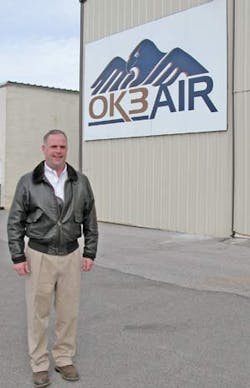Client-Focused Growth
Service, Location Variety
The company's 15,000-sq. foot facility at Salt Lake City International provides a variety of services, except fuel, says Hosack, with maintenance and charter sales providing the bulk of activity.
The Heber location, conveniently located near the popular ski areas of Park City, The Canyons, Sundance, and Deer Valley, includes a 12,000-sq.ft. building and two hangars. A brand new 14,000-sq.ft. facility attached to one of the hangars will allow for a new passenger/pilot area and future growth and will be opened in the first quarter of 2005.
OK3AIR is the only FBO on the field in Heber, along with several other tenants, including the Heber Valley Aero Museum. Heber Valley Airport is the company's primary location and "closest to our prime demographic," says Hosack.
At Ogden Airport, OK3AIR is one of two fuel providers on the field, which makes fuel sales a little "tighter" here than at Heber, says Hosack.
Fuel margins at both Ogden and Heber have been "hit pretty hard" as the cost of oil remains high, says Petersen. While the company has been able to pass that increase along somewhat at Heber because it is the only operator and it is a resort region, competition at Ogden has made it nearly impossible to do the same.
Accounting for all three locations is consolidated, with the majority of revenue (25 percent) coming from fuel sales/line service. The maintenance operation also contributes some 25 percent, while the flight school and aircraft sales account for 20 percent each and the remaining 10 percent is attributed to charter sales. In total, OK3AIR pumps some 750,000 gallons of fuel (jet-A and avgas) annually. Petersen says fuel sales at Heber have doubled every year since OK3AIR took over operations.
On its charter certificate, OK3AIR has a Citation I, a Hawker 700, and two King Airs available. Hosack calls the King Air the "prime vehicle in this region."
For 2005, say Petersen and Hosack, much focus will be given to aircraft sales. The company is the official single-engine Cessna Aircraft dealer for the Central Rocky Mountain region.
Each location has its own attractive features; and, together, all three offer customers and the company flexibility to utilize each location and each employee in the best manner possible. "Not every location is always busy," explains Hosack. "We have the ability to move employees around to where they are needed most."
Air Show,
Other Advantages
AbuHaidar and Petersen, who are "addicted to flying and aerobatics," according to Hosack, have employed their Naval aviation experience to establish the OK3AIR Air Show Team, which conducts air shows at OK3AIR facilities as well as throughout the U.S. Hosack says the air shows are a great marketing tool for the company. A particularly successful open house held at Ogden airport featured the Air Show Team, Hosack adds. "If you want to have a successful open house, have planes fly upside down."
Additionally, OK3AIR sponsors a monthly pilot seminar series free of charge with subjects ranging from the ins and outs of purchasing an aircraft to winter weather and situational awareness to mountain flying. Hosack says the sessions offer customers the opportunity to better themselves as well as learn more about OK3AIR's offerings.
Looking Toward Growth
Petersen and Hosack say OK3AIR is definitely looking to grow throughout the West, depending on opportunities and economic factors. The business model of the FBO is based on growth of customers and locations.
The company, according to Hosack, is focusing on areas of high home values, large incomes, high traffic, and "areas that lend to customers for life. That's why we do everything," he says. "We want to create customers for life." Hosack says this is the key for growth. "It's 67 times more difficult to gain new customers than it is to keep current customers. So it's paramount for us to keep current customers."
Over the last two to three years, Hosack says the customer base of the three FBOs has increased by some 4 percent.
Ultimately, Petersen says he would like to see OK3AIR become a nationwide chain of FBOs, through acquisitions, start-ups, and even franchising, wherever each makes business sense. "The large players [in the FBO arena] have jumped on large markets and have left some room for consolidation in the middle markets and the full-service operations," says Petersen.
Iindustry Influences
According to Petersen, the company does make a profit but it has not been easy. "The single largest effect on our bottom line is insurance," he says. "It's the number one expense that we have by far." OK3AIR, like much of the industry, has seen a significant increase in insurance premiums since 2001.
Competition is slowly returning to the insurance industry, says Petersen, and he expects that will allow premiums to come down some. One solution he offers to the increasing cost of insurance is allowing smaller companies to establish a buying group. "If you had a buying group, smaller companies will have more power [in controlling prices]," he says.
Petersen expects that because of increased aircraft sales in 2004, thanks to tax relief, 2005 will see a decrease in aircraft maintenance because many of those aircraft will still be under warranty. However, while flight training has been down in recent years because of the economics of the airlines, says Petersen, "this will not continue. Pilots are still going to retire and the airlines still need pilots."
